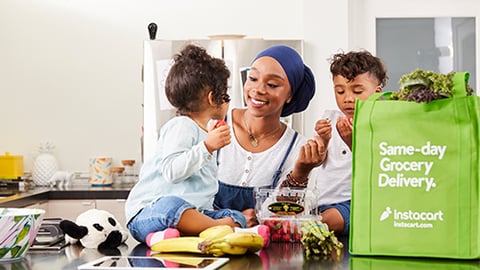Instacart Has Algorithms for Avocados
When COVID-19 overwhelmed the U.S. grocery industry in March, Instacart Chief Technology Officer Mark Schaaf recalls being in bed every night with his computer.
“There were times in March and April that I didn’t sleep, or I slept with my computer. Traffic was growing around 20% every day,” Schaaf said. “You wake up at 5 a.m. and see how much higher traffic was from 5 a.m. the previous day. And then move quickly to try to do a bunch of things to scale our systems to support customers, shoppers and retailers.”
Schaaf joined Instacart in 2018 after serving as CTO at consumer service website Thumbtack and working as an engineer at Google’s mobile display advertising division. His first love has always been grocery, however. Schaaf spent his high school years bagging groceries at Seessel’s (later Schnucks) in Tennessee. For Schaaf, coming to work at Instacart is coming full circle -- back to the industry he loved growing up.
DISCOVER MORE ON INSTACART
- The Predictable Rise: A suddenly essential service envisions grocery's digital future.
- Curbing Friction With Pickup: Customized solutions help grocers get it right.
“Grocery is deeply personal to customers,” Schaaf says. “They want the ripest avocado, and we have personalization algorithms for that. Customers are trusting us to give them a great experience.”
According to Schaaf, building a great experience on Instacart means having to match supply and demand across the company’s four-sided marketplace of customers, shoppers, retailers and consumer packaged goods (CPG) companies, and then customize it all for each market, whether it’s Tampa, Florida, or New York City.
“Nobody plans for 500% growth in a matter of weeks,” Schaaf admits, “and so we did a lot of infrastructure work to scale out our core systems.”
For the retailer and CPG pillars of the marketplace, the company has implemented “basket- boosting” features before a purchase is completed by a customer.
“‘Hey, it looks like you’re planning a barbecue. Did you forget the mustard?’” Schaaf says, in imitation of an Instacart prompt. “We want to make sure that the consumer, even at the time of checkout, is building the fullest cart possible.”
Schaaf’s engineering team has also focused on making the shopper experience safer and more efficient by retooling algorithms that route shoppers through the store in the most efficient manner, launching Leave At My Door (contactless) delivery and ASAP Delivery (quicker delivery windows), and improving the company’s “found rate,” a metric that shows how often an item is on the shelf where it’s supposed to be. The metric pre-COVID was usually above 90%. In late March, it dropped to 60%.
“Our found rate has picked back up to above 90%,” Schaaf notes, “but we had to do a lot with replacements there. We had to do a lot with prediction and letting customers know early that, for example, meat was in high demand and hard to find.”
The company has also updated its machine-learning models to help shoppers do a better job with replacements, a common customer complaint.
Going forward, at the top of Schaaf’s tech to-do list is making the checkout experience smoother for Instacart’s shopper workforce. The company has launched bypass checkout for shoppers at some retailers.
“It requires some integration between us and the retailers, but I think you'll see more of that happen over time because retailers want to make sure our shoppers are able to move quickly and efficiently through their checkout lines side-by-side with customers who are shopping in store,” he said. “There's just no end in sight to how this technology and product can evolve.”








